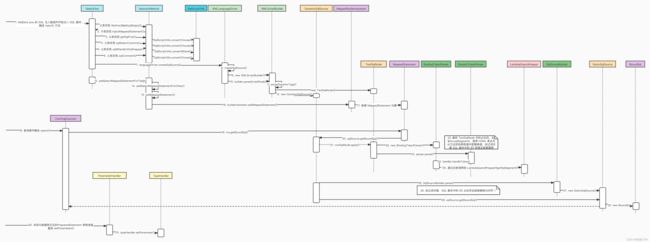MyBatis-plus 转化处理 SQL 语句的源码分析
文章目录
- 前言
- 1. MyBatis-plus 对 SQL 语句脚本的处理
-
-
- 1.1 SQL 语句脚本的构建
- 1.2 SqlSource 的转化
-
- 2. MyBatis 对 SqlSource 的使用
前言
在 MyBatis-plus 自定义通用方法及其实现原理 中笔者介绍了 MyBatis-plus 添加通用方法的实现方式,但是其中还有一些细节需要澄清,下文笔者将详细分析
MyBatis-plus对 SQL 语句脚本的构建,以及将其嵌入MappedStatement的过程MyBatis使用SqlSource构建可执行的 SQL 语句
1. MyBatis-plus 对 SQL 语句脚本的处理
我们都知道 MyBatis-plus 干掉了繁琐的 XML 文件,使 MyBatis 框架的易用度、好用度大幅上升。在MyBatis-plus 源码解析 中笔者提到过,MyBatis-plus 实际是将 Mapper 方法映射为了对应的 SQL 语句脚本,这个步骤的核心就是 AbstractMethod#injectMappedStatement() 的子类实现,本文以 SelectOne#injectMappedStatement() 为例进行分析,其主要处理分为两个部分:
- SQL 语句脚本的构建
- 解析 SQL 语句脚本,将其转化为
SqlSource封装到MappedStatement中
1.1 SQL 语句脚本的构建
-
SelectOne#injectMappedStatement()方法如下,SQL 语句脚本的构建实际在一个以SqlMethod.SELECT_ONE为主体的String#format()拼接操作中,重要调用的如下:- 通过
sqlMethod.getSql()调用SqlMethod.SELECT_ONE#getSql()方法获得 SQL 脚本主体字符串 - 调用
AbstractMethod#sqlFirst()构建 SQL 脚本在正式 SQL 语句之前的部分,这里会使用字符串替换${ew.sqlFirst} - 调用
AbstractMethod#sqlSelectColumns()构建 SQL 语句 SELECT 查询的字段相关的脚本部分,此处会使用字符串替换${ew.sqlSelect} - 调用
TableInfo#getTableName()获取实际的要查询的表名 - 调用
AbstractMethod#sqlWhereEntityWrapper()构建 SQL 语句 WHERE 条件相关的脚本部分,此处会使用字符串替换${ew.sqlSegment} - 调用
AbstractMethod#sqlComment()构建 SQL 语句尾部注释相关的脚本部分,此处会使用字符串替换${ew.sqlComment}
@Override public MappedStatement injectMappedStatement(Class<?> mapperClass, Class<?> modelClass, TableInfo tableInfo) { SqlMethod sqlMethod = SqlMethod.SELECT_ONE; SqlSource sqlSource = languageDriver.createSqlSource(configuration, String.format(sqlMethod.getSql(), sqlFirst(), sqlSelectColumns(tableInfo, true), tableInfo.getTableName(), sqlWhereEntityWrapper(true, tableInfo), sqlComment()), modelClass); return this.addSelectMappedStatementForTable(mapperClass, getMethod(sqlMethod), sqlSource, tableInfo); } - 通过
-
SqlMethod.SELECT_ONE#getSql()方法实际只是个获取操作,只要看下这个枚举的定义就知道这里拿到的是个使用%s占位的脚本字符串public enum SqlMethod { ...... SELECT_ONE("selectOne", "查询满足条件一条数据", ""), private final String method; private final String desc; private final String sql; SqlMethod(String method, String desc, String sql) { this.method = method; this.desc = desc; this.sql = sql; } public String getMethod() { return method; } public String getDesc() { return desc; } public String getSql() { return sql; } } -
AbstractMethod#sqlFirst()的实现很简单,可以看到这里实际就是使用SqlScriptUtils#convertChoose()工具类拼接 SQL 语句脚本 标签的过程,经过处理这里可以得到的脚本片段如下<choose> <when test="ew != null and ew.sqlFirst != null"> ${ew.sqlFirst} when> <otherwise>otherwise> choose>protected String sqlFirst() { return SqlScriptUtils.convertChoose(String.format("%s != null and %s != null", WRAPPER, Q_WRAPPER_SQL_FIRST), SqlScriptUtils.unSafeParam(Q_WRAPPER_SQL_FIRST), EMPTY); } -
SqlScriptUtils#convertChoose()方法如下,显然就是标签字符串的构造,没有特别操作public static String convertChoose(final String whenTest, final String whenSqlScript, final String otherwise) { return "" + NEWLINE + "+ whenTest + QUOTE + RIGHT_CHEV + NEWLINE + whenSqlScript + NEWLINE + " " + NEWLINE + "" + otherwise + "" + NEWLINE + ""; } -
AbstractMethod#sqlSelectColumns()的处理大同小异,其实就是指定查询表的字段,此处可以得到如下脚本片段<choose> <when test="ew != null and ew.sqlSelect != null"> ${ew.sqlSelect} when> <otherwise>id,name,typeotherwise> choose>protected String sqlSelectColumns(TableInfo table, boolean queryWrapper) { /* 假设存在 resultMap 映射返回 */ String selectColumns = ASTERISK; if (table.getResultMap() == null || (table.getResultMap() != null && table.isInitResultMap())) { /* 普通查询 */ selectColumns = table.getAllSqlSelect(); } if (!queryWrapper) { return selectColumns; } return SqlScriptUtils.convertChoose(String.format("%s != null and %s != null", WRAPPER, Q_WRAPPER_SQL_SELECT), SqlScriptUtils.unSafeParam(Q_WRAPPER_SQL_SELECT), selectColumns); } -
AbstractMethod#sqlWhereEntityWrapper()的处理稍显复杂,不过原理和以上方法是一样的,此处可以获得如下脚本片段<if test="ew != null"> <where> <if test="ew.entity != null"> <if test="ew.entity.id != null">id=#{ew.entity.id}if> <if test="ew.entity['name'] != null">AND name=#{ew.entity.name}if> <if test="ew.entity['type'] != null">AND type=#{ew.entity.type}if> if> <if test="ew.sqlSegment != null and ew.sqlSegment != '' and ew.nonEmptyOfWhere"> <if test="ew.nonEmptyOfEntity and ew.nonEmptyOfNormal">ANDif> ${ew.sqlSegment} if> where> <if test="ew.sqlSegment != null and ew.sqlSegment != '' and ew.emptyOfWhere"> ${ew.sqlSegment} if> if>protected String sqlWhereEntityWrapper(boolean newLine, TableInfo table) { if (table.isLogicDelete()) { String sqlScript = table.getAllSqlWhere(true, true, WRAPPER_ENTITY_DOT); sqlScript = SqlScriptUtils.convertIf(sqlScript, String.format("%s != null", WRAPPER_ENTITY), true); sqlScript += (NEWLINE + table.getLogicDeleteSql(true, true) + NEWLINE); String normalSqlScript = SqlScriptUtils.convertIf(String.format("AND ${%s}", WRAPPER_SQLSEGMENT), String.format("%s != null and %s != '' and %s", WRAPPER_SQLSEGMENT, WRAPPER_SQLSEGMENT, WRAPPER_NONEMPTYOFNORMAL), true); normalSqlScript += NEWLINE; normalSqlScript += SqlScriptUtils.convertIf(String.format(" ${%s}", WRAPPER_SQLSEGMENT), String.format("%s != null and %s != '' and %s", WRAPPER_SQLSEGMENT, WRAPPER_SQLSEGMENT, WRAPPER_EMPTYOFNORMAL), true); sqlScript += normalSqlScript; sqlScript = SqlScriptUtils.convertChoose(String.format("%s != null", WRAPPER), sqlScript, table.getLogicDeleteSql(false, true)); sqlScript = SqlScriptUtils.convertWhere(sqlScript); return newLine ? NEWLINE + sqlScript : sqlScript; } else { String sqlScript = table.getAllSqlWhere(false, true, WRAPPER_ENTITY_DOT); sqlScript = SqlScriptUtils.convertIf(sqlScript, String.format("%s != null", WRAPPER_ENTITY), true); sqlScript += NEWLINE; sqlScript += SqlScriptUtils.convertIf(String.format(SqlScriptUtils.convertIf(" AND", String.format("%s and %s", WRAPPER_NONEMPTYOFENTITY, WRAPPER_NONEMPTYOFNORMAL), false) + " ${%s}", WRAPPER_SQLSEGMENT), String.format("%s != null and %s != '' and %s", WRAPPER_SQLSEGMENT, WRAPPER_SQLSEGMENT, WRAPPER_NONEMPTYOFWHERE), true); sqlScript = SqlScriptUtils.convertWhere(sqlScript) + NEWLINE; sqlScript += SqlScriptUtils.convertIf(String.format(" ${%s}", WRAPPER_SQLSEGMENT), String.format("%s != null and %s != '' and %s", WRAPPER_SQLSEGMENT, WRAPPER_SQLSEGMENT, WRAPPER_EMPTYOFWHERE), true); sqlScript = SqlScriptUtils.convertIf(sqlScript, String.format("%s != null", WRAPPER), true); return newLine ? NEWLINE + sqlScript : sqlScript; } } -
AbstractMethod#sqlComment()拿到的脚本片段如下,不做更多解释<choose> <when test="ew != null and ew.sqlComment != null"> ${ew.sqlComment} when> <otherwise>otherwise> choose>protected String sqlComment() { return SqlScriptUtils.convertChoose(String.format("%s != null and %s != null", WRAPPER, Q_WRAPPER_SQL_COMMENT), SqlScriptUtils.unSafeParam(Q_WRAPPER_SQL_COMMENT), EMPTY); }
经过以上步骤,SQL 语句脚本各个关键的片段都已经构建完毕,最终得到的脚本如下所示。接下来的处理就是解析这个脚本,通过 LanguageDriver#createSqlSource() 方法将脚本转化为 SqlSource 对象,这个对象是决定最终执行的 SQL 语句的重中之重
<script>
<choose>
<when test="ew != null and ew.sqlFirst != null">
${ew.sqlFirst}
</when>
<otherwise></otherwise>
</choose>
SELECT
<choose>
<when test="ew != null and ew.sqlSelect != null">
${ew.sqlSelect}
</when>
<otherwise>id,name,type</otherwise>
</choose>
FROM node
<if test="ew != null">
<where>
<if test="ew.entity != null">
<if test="ew.entity.id != null">id=#{ew.entity.id}</if>
<if test="ew.entity['name'] != null">AND name=#{ew.entity.name}</if>
<if test="ew.entity['type'] != null">AND type=#{ew.entity.type}</if>
</if>
<if test="ew.sqlSegment != null and ew.sqlSegment != '' and ew.nonEmptyOfWhere">
<if test="ew.nonEmptyOfEntity and ew.nonEmptyOfNormal">AND</if>
${ew.sqlSegment}
</if>
</where>
<if test="ew.sqlSegment != null and ew.sqlSegment != '' and ew.emptyOfWhere">
${ew.sqlSegment}
</if>
</if>
<choose>
<when test="ew != null and ew.sqlComment != null">
${ew.sqlComment}
</when>
<otherwise></otherwise>
</choose>
script>
1.2 SqlSource 的转化
-
LanguageDriver#createSqlSource()是接口方法,MyBatis使用 XML 来定义 SQL 语句配置的,实际调用到XMLLanguageDriver#createSqlSource(),可以看到这里最终调用XMLScriptBuilder#parseScriptNode()开始解析 XML 脚本public SqlSource createSqlSource(Configuration configuration, String script, Class<?> parameterType) { // issue #3 if (script.startsWith("
